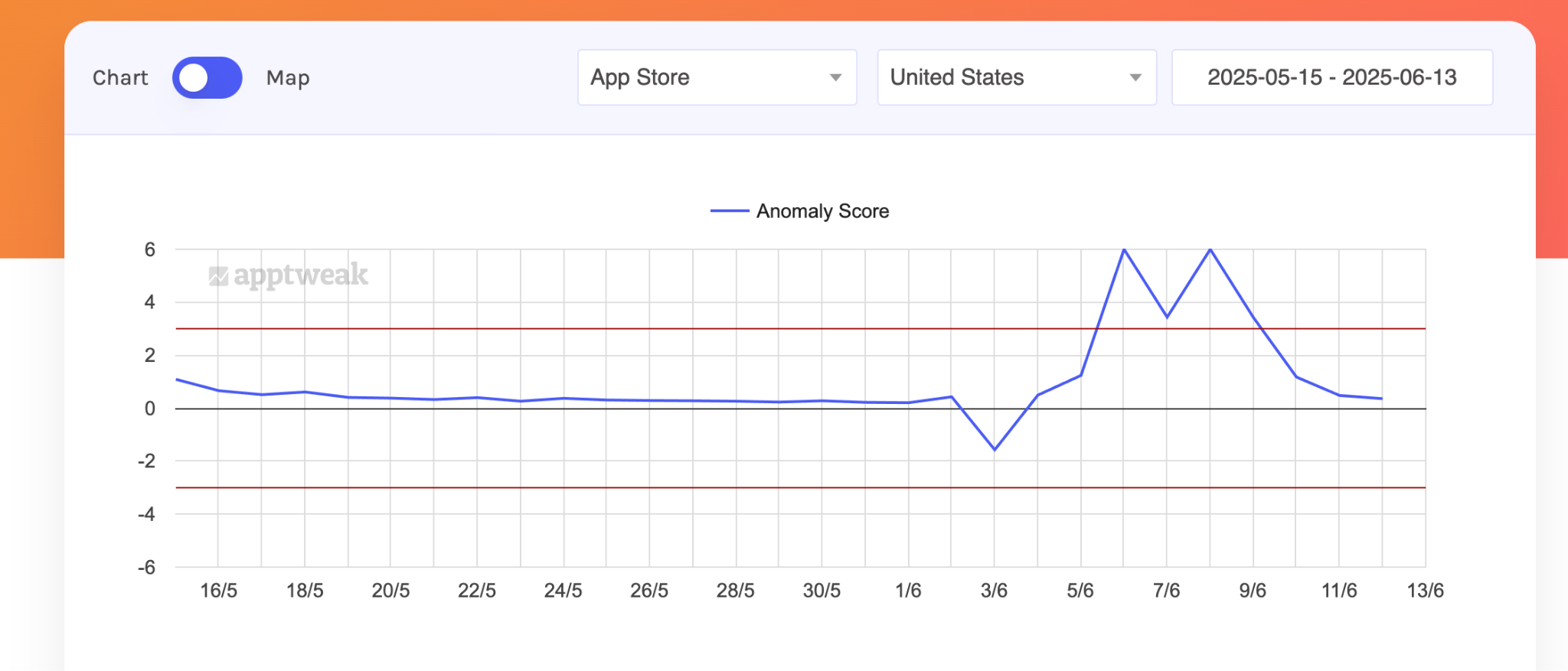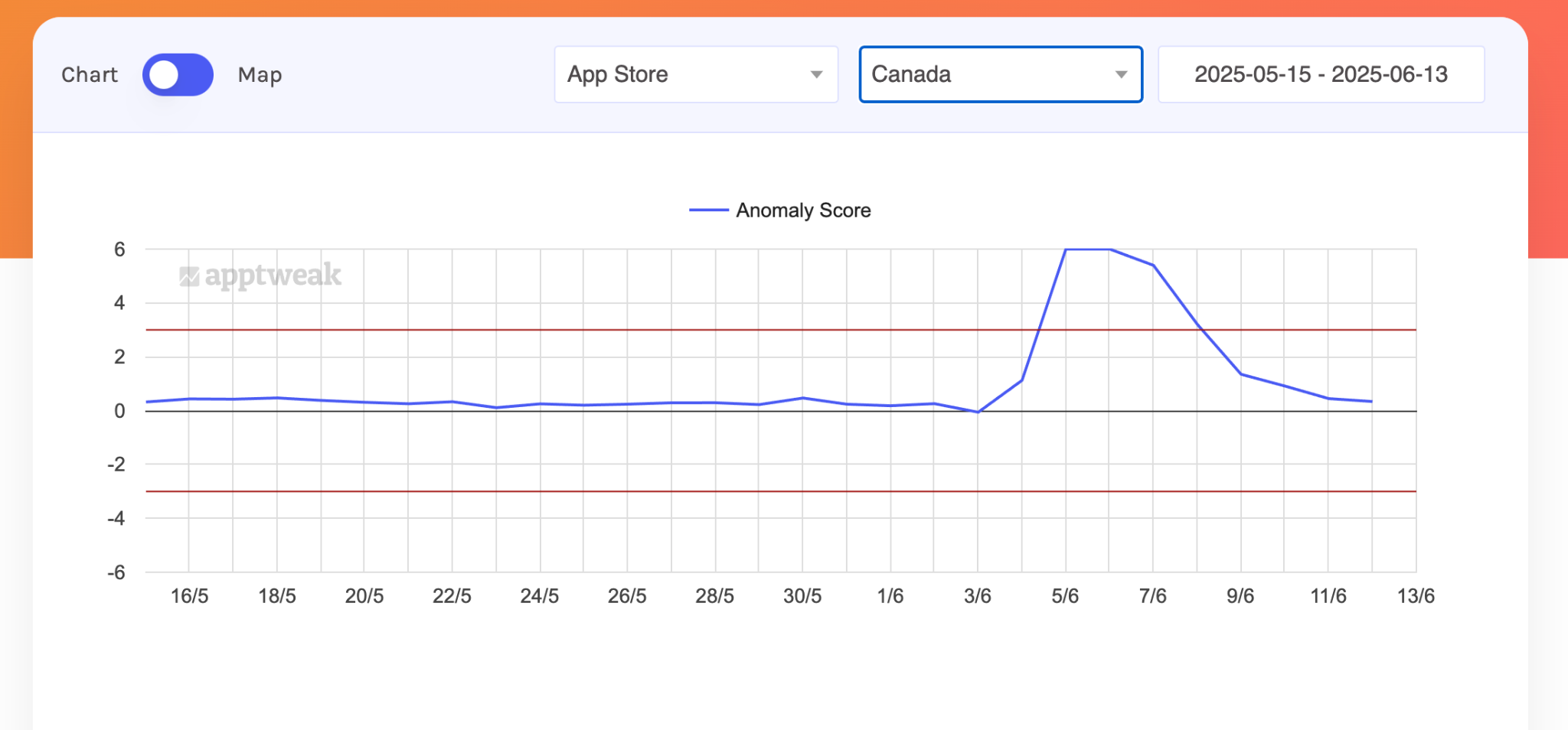Did the App Store (ASO) algorithm really change – or is it just a fluke?
Over the past week, many app publishers (myself included) have noticed sharp drops in keyword rankings in the App Store, particularly in English-speaking countries such as the United States, United Kingdom, Canada, and Australia. These changes have affected even long-standing apps, which may indicate a significant update to Apple’s search algorithm.
These ranking drops are also reflected in the data. AppTweak, a tool that monitors anomalies in keyword rankings, recorded a noticeable spike in the so-called Anomaly Score between June 5–9, 2025. The values exceeded the +3 threshold, reaching as high as +6 on June 7 and 8 — clearly indicating major ranking shifts and a potential change to the App Store’s algorithm.


Amid these ranking drops, an interesting analysis emerged from Ariel Michaeli, CEO of the App Store Optimization tool Appfigures. According to him, Apple may have introduced a new ranking factor into its algorithm — text from app screenshots, extracted using OCR (optical character recognition) technology. You can find the full article here.
This is a significant change that could greatly impact App Store Optimization (ASO) strategies in 2025.
What exactly has changed, according to Ariel Michaeli from Appfigures?
Based on his analysis:
- Apple is now extracting text from captions visible in app screenshots,
- This text is treated as an additional source of keywords,
- Apps that include relevant phrases in their visuals have gained visibility,
- Apps without such captions, or with generic text, have seen ranking drops.
In the past, according to Ariel, only the app name, subtitle, and keyword list influenced search rankings. If Apple has indeed started considering text from screenshots, this marks one of the most significant ASO changes in years.
From my own experience, keywords used in in-app events and phrases included in in-app purchase names can also affect rankings. Additionally, keyword position is influenced by the number of downloads attributed to that specific term, as well as the retention of users acquired through it.
Key Takeaways from the Appfigures Analysis
1. Text in screenshots supports app ranking
Apps that include keywords in their screenshot captions are seeing improvements in search results. In many cases, these are phrases that were not previously included in the app’s metadata.
2. OCR analyzes only part of the image
Apple is likely scanning only the top and bottom areas of screenshots — where captions are typically placed.
3. Visual style matters
- For the text to be effectively recognized by the algorithm:
- Avoid gradients and low-contrast backgrounds,
- Use simple, legible fonts,
- Ensure the text is large enough to be easily read on a smartphone screen.
What to Do to Maintain Visibility in the App Store (According to Ariel)
Review your screenshots
Sprawdź, czy:
- They include real keywords rather than vague slogans,
- They are consistent with your app’s name and subtitle,
- The captions are clear and well-positioned.
Optimize your captions
Instead of using generic phrases like “All-in-One” or “Best App”, include specific search-driven keywords, for example:
- “Sleep Tracker for Women”
- “Learn Spanish Fast”
- “Photo Editor with AI”
Monitor your competitors
Use ASO tools to analyze how top-ranking apps structure their captions. Pay close attention to graphic style, text placement, and the specific phrases they use.
Checklist – How to Make Your Screenshots OCR-Ready
- Place key phrases at the top or bottom of the screen
- Use high contrast between text and background
- Choose simple, legible fonts (avoid decorative styles)
- Ensure the text is large enough to be easily read
- One screenshot = one keyword or key phrase
- Avoid repeating the same phrase across multiple screenshots
- Align captions with other metadata elements (app name, subtitle, keyword list)
Do Screenshots Really Impact Keyword Rankings?
Personally, I haven’t yet seen a direct impact of screenshot text on keyword rankings. I doubt Apple would take this route, as it could negatively affect the visual quality of App Store creatives — which might end up flooded with keyword-stuffed captions.
On the other hand, the scale of anomalies reported by AppTweak clearly shows major ranking shifts across many English-speaking countries. This could indeed be the result of a new algorithm — or just a temporary bug on Apple’s side. Either way, it’s a topic worth closely monitoring.
What about your app or mobile game — have you noticed any keyword ranking changes?
Summary: App Store Optimization in 2025 Requires Vigilance
Whether this is a bug, an A/B test, or a permanent algorithm change — it’s worth making sure your screenshots align with the new approach right now.
If you’ve noticed ranking drops, start your analysis with your screenshots. This might be the key factor determining your app’s visibility in the App Store over the coming weeks.
Apple Search Ads Joins SKAN, AdAttributionKit on April 10
Over the past week, many app publishers (myself included) have noticed sharp drops in...

